The Heuchera Guide
Heuchera, commonly known as coral bells, are versatile perennials grown primarily for their colorful foliage and mounding form. With leaves ranging from lime green to deep burgundy, silvery purple, and fiery orange, these plants provide four-season interest and stunning contrast in both sun and shade gardens. While their foliage is the main attraction, delicate flower spikes emerge in late spring to early summer, adding a graceful vertical element and attracting pollinators.
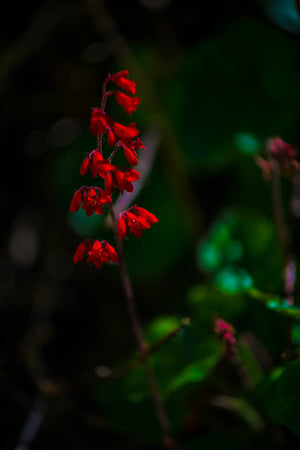
About
Heuchera are native to North America and belong to the Saxifragaceae family. Most varieties are evergreen or semi-evergreen, forming low-growing mounds of scalloped leaves in hues of burgundy, chartreuse, amber, silver, and near-black. While they are valued primarily for their foliage, many heuchera also produce delicate spires of bell-shaped flowers that attract hummingbirds and pollinators from late spring into summer.
Modern hybrids offer a wide array of foliage textures and tones. Heuchera 'Caramel' brings warm, golden-apricot hues to the shade garden, while 'Plum Pudding' adds dramatic purple coloring with a metallic sheen. Silver-leafed varieties like 'Silver Scrolls' and 'Glitter' offer striking contrast against green plantings. Others, like 'Fire Alarm' and 'Fire Chief', bring vivid reds to the front of mixed borders, while 'Citronelle' adds a chartreuse pop to shady areas.
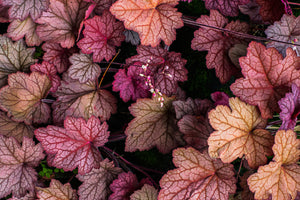
PLANTING
Heuchera are adaptable and easy to grow, making them suitable for a variety of garden conditions:
- USDA Hardiness Zones: Typically hardy in Zones 4–9. Some southern U.S. hybrids derived from Heuchera villosa, like 'Carnival Watermelon', tolerate heat and humidity better.
- Soil: Well-drained, fertile soil with consistent moisture is best. Heavy clay can be amended with compost or leaf mold.
- Sunlight: Partial shade to full shade is ideal, especially for lighter-colored cultivars. In cooler climates, many varieties tolerate more sun.
- Spacing: Space plants 12–18 inches apart, depending on mature spread.
- Planting Time: Plant in spring or early fall to allow roots to establish before extreme weather.
Avoid planting too deep; the crown of the plant should remain just at or above soil level to prevent rot. Mulch lightly around the base, but keep mulch off the crown.
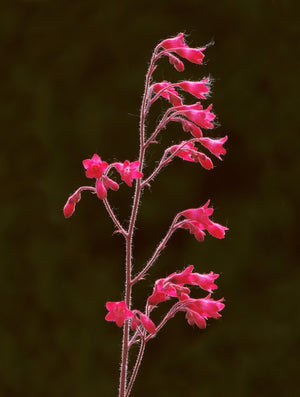
CARE
Heuchera require minimal care once established, but they benefit from a few seasonal maintenance tasks to remain at their best:
- Watering: Keep soil evenly moist but not soggy. New plants need regular water until established. Mature plants are somewhat drought tolerant.
- Fertilizing: Apply a balanced, slow-release fertilizer in early spring to support healthy foliage and flower development.
- Deadheading: Remove spent flower stalks to tidy up the plant and encourage continued blooming.
- Dividing: Divide every 3–4 years in spring or early fall to refresh crowded clumps and maintain vigor. Cultivars like 'Amethyst Myst' and 'Green Spice' respond well to rejuvenation.
- Winter Care: In colder climates, heuchera may heave from the ground during freeze-thaw cycles. Apply a protective winter mulch after the ground freezes to help keep crowns stable.
Inspect crowns in early spring and reset any plants that have lifted. Remove any damaged or discolored foliage as new leaves emerge.
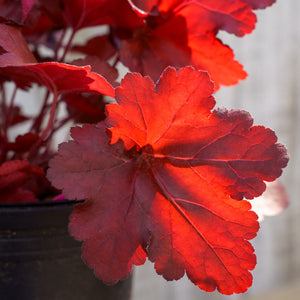
HOW TO USE
Heuchera offer year-round texture and a designer’s range of colors. Use them to create bold foliage combinations or subtle contrasts:
- Shady Borders: Combine burgundy varieties like 'Amethyst Myst' with golden-leaved cultivars like 'Citronelle' and soft silver tones from 'Glitter' for layered interest.
- Woodland Gardens: Interplant with ferns, brunnera, epimedium, and hellebores to create a lush, semi-shaded understory.
- Containers: Excellent for pots, where foliage plays a central role. Pair with trailing ivy or upright grasses for texture.
- Pollinator Gardens: Tall flower spikes attract bees and hummingbirds, providing both beauty and ecological benefit.
- Color Accents: Use coral bells in front of hostas or along pathways for a pop of color and tidy form.
Heuchera also work beautifully with sedges and other shade-tolerant perennials, especially those with contrasting leaf shapes and colors.
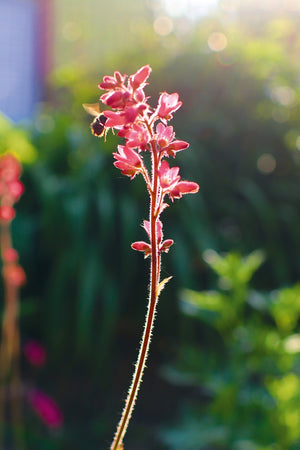
COMMON QUESTIONS
- Are Heuchera deer resistant? Yes, most heuchera varieties are deer resistant due to their mildly bitter foliage.
- How to divide Heuchera? In early spring or fall, dig up the clump, gently pull apart or cut sections with healthy roots and replant at crown level.
- How to grow Heuchera? Plant in well-drained soil in partial shade, water regularly until established, and divide every few years to maintain health.
- What to plant with Heuchera? Good companions include hosta, tiarella, astilbe, carex, pulmonaria, and spring bulbs like daffodils.
- Are Heuchera toxic to dogs? Heuchera is not considered highly toxic but may cause mild stomach upset if ingested.
- Are Heuchera toxic to cats? Like with dogs, Heuchera is not listed as highly toxic, though ingestion can lead to mild digestive issues.
- Do rabbits eat Heuchera? Heuchera is generally rabbit resistant, though young plants may be nibbled in early spring.
Conclusion
Heuchera are among the most adaptable and colorful foliage perennials for shady to partially sunny landscapes. With modern cultivars offering a spectrum of vibrant hues and textures, coral bells elevate garden design while staying low-maintenance and deer resistant. Whether used in containers, borders, or woodland gardens, Heuchera bring dependable structure, seasonal interest, and visual sophistication to any planting scheme.
The Heuchera Collection
Sold Out
Sold Out
Sold Out
Sold Out






